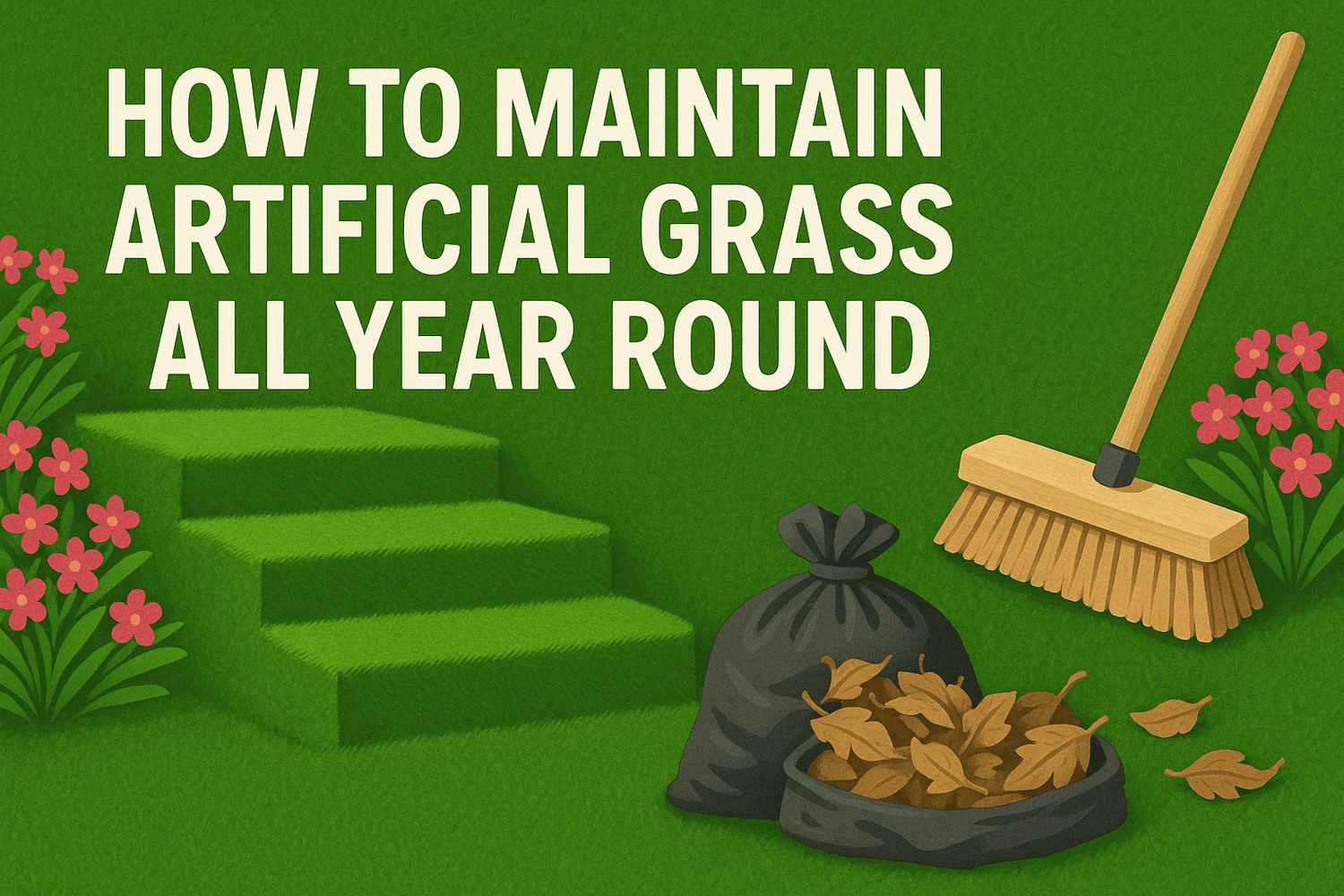Artificial grass is popular because it looks good all year and doesn’t need mowing or watering. Many people choose it for homes, schools, and playgrounds.
One big reason is the low maintenance commitment. You save time and water. That’s helpful, especially in areas with water restrictions.
But even though it’s easier than real grass, it still needs some care. Dust, leaves, and pet waste can build up over time. Without cleaning, the turf can flatten or smell bad.
In this guide, you’ll learn:
- How to keep your artificial lawn clean
- Which maintenance tools you need
- Simple steps for each season
- When to clean, brush, or rinse your turf
Why Artificial Grass Still Needs Regular Maintenance
Some people think artificial turf takes care of itself. That’s not true. It doesn’t grow, but it still gets dirty.
Without cleaning, grass blades can get flat. Dust and debris can stay trapped. Pet urine may cause pet odours. Over time, this can make your turf look old and worn out.
Regular care and maintenance helps keep your yard fresh and safe. It also helps your turf last longer.
With proper cleaning, synthetic turf can last 15–20 years. Without care, it may need replacing in just 8–10 years. That’s a big difference when you think about installation costs.
If you're looking for high-quality artificial turf that’s easy to maintain and built to last, LITA Grass is a great choice. Their turf is designed to resist pet odours, flattening, and UV damage—so it holds up better with routine care. Whether you want turf for your backyard, balcony, or pet area, LITA offers several options that look and feel like real grass.
Essential Weekly and Monthly Maintenance Tasks
Keeping your artificial grass clean doesn't take much time. Just a few simple tasks can keep it looking fresh.
Brushing the Grass
Use a push broom, power broom, or a tool like an artificial turf brush. Avoid anything with metal bristles—they can damage the turf.
Brush in different directions. This is called cross brushing. It keeps the grass blades standing up.
Removing Leaves and Debris
Clear out leaves, twigs, and other debris once a week. Use a plastic rake or a leaf blower. Don’t use a vacuum cleaner—it might suck up the infill.
This helps with weed control and stops mould growth.
Rinsing the Surface
Use a garden hose to rinse off dust, pollen, and dirt. A quick spray once a week is enough in most cases. This also helps wash away pet urine and light stubborn stains.
If the smell is strong, try using enzyme concentrate made for pet waste cleanup.
Weekly/Monthly Maintenance Checklist
|
Task |
Tools Needed |
How Often |
|
Brush the turf |
Power broom or push broom |
Weekly–Monthly |
|
Remove leaves and debris |
Leaf blower or plastic rake |
Weekly |
|
Rinse turf surface |
Garden hose |
Weekly–Biweekly |
|
Clean pet areas |
Enzyme cleaner, water |
Weekly |
Seasonal Guide: How to Maintain Artificial Grass All Year Round
Artificial grass needs different care during each season. Some months bring more dust, others bring leaves, or even snow. Follow these simple tips to keep your turf clean all year.
Spring Artificial Grass Care
After winter, it’s time for a deep cleaning. Use a garden hose to rinse off built-up dirt and dust. If there are stubborn stains, spot clean with mild soap and water.
Look for weeds around the edges. Check for small damage in seams or the drainage system. Good weed control now helps stop bigger problems later.
You can also schedule a professional artificial turf cleaning service if your lawn looks dull after winter.
Summer Artificial Grass Maintenance Tips
In hot weather, turf gets dusty faster. Rinse the surface with water more often, especially if you live in dry areas or where there are water restrictions.
To avoid heat build-up, try rinsing your artificial turf in the early morning. You can also install shade or use turf cooling sprays if needed.
Pet urine smell gets stronger in summer. Clean the pet area more often. Use enzyme concentrate or turf-safe ClO2 cleaning products to help with pet odours.
Autumn Maintenance for Synthetic Lawns
Leaves fall fast in autumn. Remove them quickly using a plastic rake or leaf blower. If leaves stay too long, they can trap moisture and cause mould growth.
Use your power broom or fiber brushing machines more often to lift flattened grass blades. This keeps your turf looking full and healthy.
Also check infill levels and top up if needed.
Winter Turf Care Tips
In winter, turf may freeze. Don't use salt or harsh weed killer to melt ice. Salt can damage artificial turf products.
Let snow melt on its own. If needed, use a soft broom to push off loose snow. Never use a shovel—it can damage the turf.
Avoid walking on frozen turf. It can cause the grass blades to flatten or crack.
Pet Turf Maintenance: Keeping It Fresh and Clean
Pets love synthetic turf too, but their mess needs attention.
Pick up solid pet waste right away. Use a scoop or bag. For pet urine, rinse the spot with a garden hose at least once a week.
Use enzyme concentrate or a turf-safe deodoriser to keep smells away. This also helps stop bacteria from growing.
For better hygiene, use antimicrobial infill under pet zones. It helps absorb smells and moisture.
If you have many pets, rinse the turf more often. A clean pet area keeps your whole artificial lawn fresh.
Infill Care and Redistribution Tips
Infill sits between the grass blades. It helps them stand up and adds cushion. It also helps with drainage system flow.
Common infill types include:
- Sand
- Crumb rubber
- Zeolite (great for pet waste cleanup)
Check your turf for low spots or flattened areas. That may mean you need infill replenishing.
Use a power broom or artificial grass power brush to move the infill around evenly. This keeps the turf smooth and soft.
Weed and Moss Control for Synthetic Lawns
Even though synthetic grass products don’t grow weeds, weeds can still appear. They often grow along the edges, in gaps, or when the infill levels are low. Bad turf installation or a missing weed barrier can also cause problems.
To stop this, use a strong weed membrane under your turf. Make sure the borders are sealed to block roots from getting in.
If weeds do show up, pull them out by hand. For bigger patches, you can use a light weed killer that’s safe for artificial turf products. Always follow the label and spray carefully.
Moss killer helps if your yard is shaded or holds water. Use a soft brush to remove moss or algae after spraying.
Tools You Need for Year-Round Artificial Grass Care
Using the right maintenance tools keeps your artificial grass looking new. Here’s what to use—and what to avoid.
Brushes
Use a push broom, power broom, or artificial grass power brush to lift the grass blades. Never use brushes with metal bristles. They can rip the turf.
Leaf Blowers vs Vacuums
A leaf blower is perfect for clearing leaves and light debris. Don’t use a vacuum cleaner—it may suck out the infill.
Cleaning Products
You can mix soap and water for basic cleaning. For pet smells or tough stains, try enzyme concentrate, turf-safe ClO2 cleaning products, or a professional artificial turf cleaning service.
Tool Use Comparison Chart
|
Tool |
Use |
Avoid When |
|
Push broom / Power broom |
Lifts grass blades |
Using too much pressure |
|
Leaf blower |
Clears leaves and debris |
Blowing infill out |
|
Plastic rake |
Gentle debris removal |
Raking too hard |
|
Enzyme cleaner |
Removes pet odours |
Using too much in one spot |
|
Garden hose |
Light rinsing |
High pressure near seams |
|
Vacuum cleaner |
❌ Don’t use on turf |
May remove infill and damage turf |
Common Artificial Grass Maintenance Mistakes to Avoid
Even small mistakes can harm your turf. Here’s what to watch out for:
- Overbrushing or using the wrong brush can flatten or tear the turf. Stick to soft tools.
- Ignoring pet waste leads to smells and bacteria. Always clean up after pets.
- Using harsh chemicals can damage your turf or backing.
- Don’t put BBQs, mirrors, or hot tools on turf. They can melt it.
- Letting leaves or trash pile up invites weeds and mould.
Quick Maintenance Checklist by Frequency
Here’s a quick guide to help you stay on top of things:
|
Task |
Frequency |
|
Brush turf |
Weekly or biweekly |
|
Rinse surface |
Every 1–2 weeks |
|
Remove debris |
Weekly |
|
Pet odour treatment |
Weekly |
|
Check infill level |
Every 6–12 months |
|
Deep clean |
Every 3–6 months |
Tip: Save this list and put it on your fridge or garden shed for easy use.
Conclusion
Taking care of artificial turf doesn’t take much time. A few small steps each week make a big difference.
Clean turf looks better, smells better, and lasts longer. Your yard stays safe for kids and pets too.
By learning how to maintain artificial grass all year round, you can enjoy a lush, low-maintenance lawn in every season.
Quality turf also makes a big difference. If your current lawn doesn’t hold up, consider switching to a premium brand like LITA Grass. It’s easier to maintain and lasts longer with proper care.



Leave a comment
This site is protected by hCaptcha and the hCaptcha Privacy Policy and Terms of Service apply.